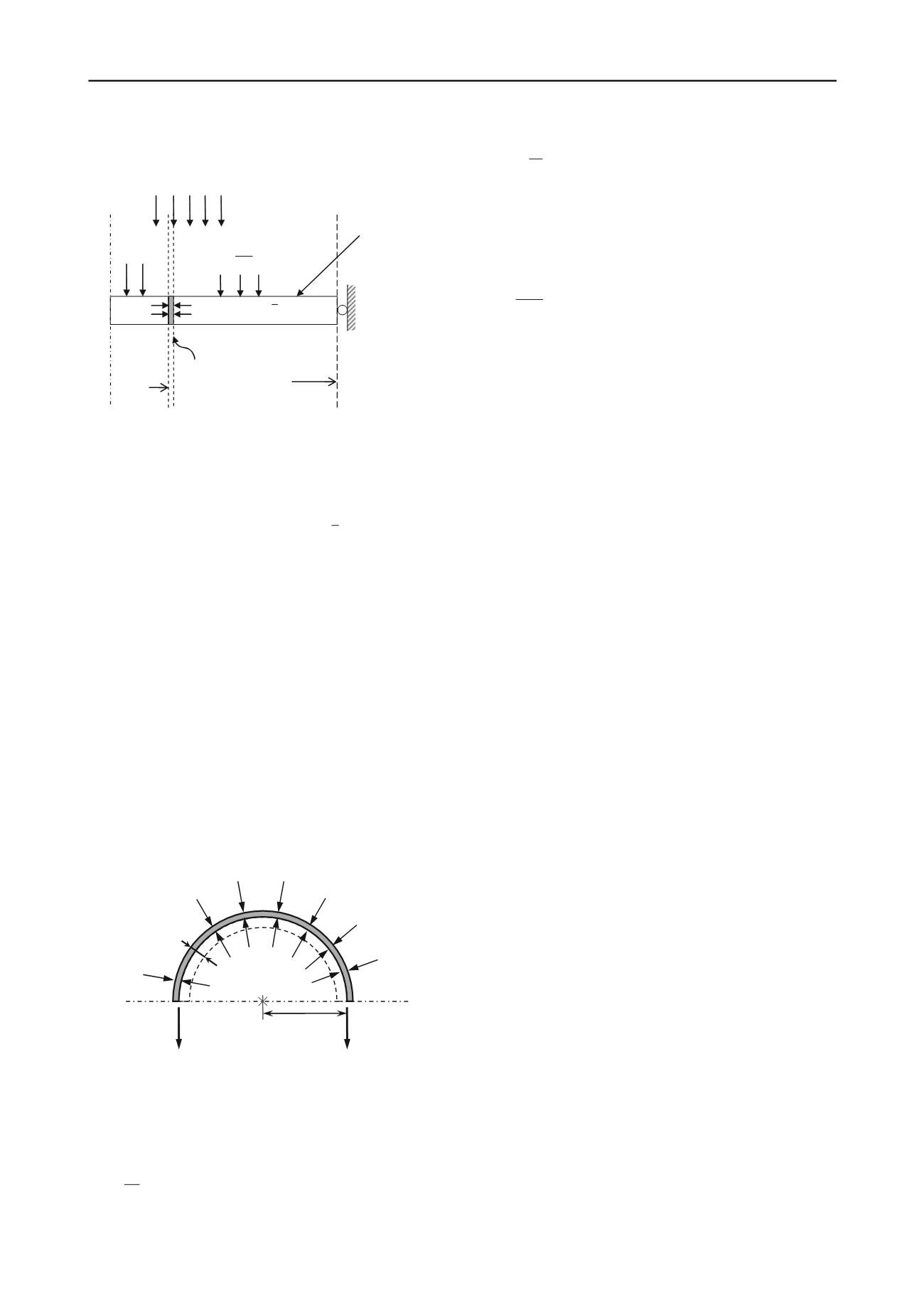
2446
Proceedings of the 18
th
International Conference on Soil Mechanics and Geotechnical Engineering, Paris 2013
behaviour of the whole unit cell is obtained by means of
integration of the solution at the different depths.
r
c
r
l
zc
zs
rs
rc
Soil
Column
Axis
a
p
Horizontal slice
at any depth,
z
u
Encasement
Figure 1. Analytical model.
2.2
Consolidation
The analysis of consolidation around encased stone columns as
a fully coupled problem is difficult to deal with. As a
simplifying assumption, the solution uses the average value of
the excess pore pressure along the radius,
u
, which is a simple
way of getting a reasonably accurate solution. The details of this
kind of approach can be found in Castro and Sagaseta (2009).
Multiple instantaneous load steps may be considered. The
column (drain) is considered to be fully permeable, which is
doubtful for conventional stone columns but is reasonable if the
columns are coated with a geotextile. In this way, consolidation
around encased stone columns is studied using any conventional
solution for radial consolidation (e.g. Barron 1948) and a
modified coefficient of consolidation that accounts for the
influence of column and encasement.
2.3
Encasement
The encasement is modelled as a cylindrical shell of negligible
thickness around the column. Therefore, it is valid for different
types of coating, such as geotextiles, geogrids... Encasement
behaviour is supposed to be linear elastic-perfectly plastic and
characterized by a tensile stiffness,
J
g
, and a maximum tensile
strength,
T
g,max
. During column installation, the encasement is
pre-stressed to an initial tensile stress,
T
g,i
. The encasement
tensile stress obtained with the analytical solution is the
increment from that value,
T
g
.
r
c
T
g
T
g
rs
rc
s
r
Figure 2. Equilibrium and compatibility conditions of the encasement.
The encasement is compressed in vertical direction, and as it
can only take tension, it does not have any influence in vertical
direction. Its equilibrium and compatibility conditions (Figure
2) are those of a thin tube under internal,
σ
rc
, and external
pressure,
σ
rs
.
rs
c
g
rc
r
T
(1)
c
r
g
g
r
s J T
(2)
where
s
r
is the radial displacement of the interface.
Combining these two equations, the radial equilibrium
between soil and column at their interface depends on the
encasement properties (stiffness and radius) and its radial
expansion.
rs
c
rg
rc
r
sJ
2
(3)
Those simple equations (Eq. 2 and 3) show how the
encasement influence depends on its stiffness and radius.
2.4
Formulation
The detailed formulation of the solution can be found in Castro
and Sagaseta (2009, 2011). Three different possible phases are
identified: (a) soil, column and encasement in the elastic range,
(b) column yielding and (c) encasement yielding, which will
occur after column yielding in a real situation.
A sensible design should cause yielding of the column but
not of the encasement. Therefore, the last phase of the solution
may not be considered and it is just necessary to check that the
tensile stress of the encasement does not exceed its strength.
The solution considers just one instantaneous load step, but it
is quite straightforward to generalize it for multiple loading
steps (Castro and Sagaseta 2008), taking the initial stresses as
the final ones of the previous load step. However, modelling the
real loading steps is only necessary to study the consolidation
process but not for the final values as it gives the same results.
2.5
Drained solution
The studied closed-form solution models the consolidation
process. However, consolidation around stone columns,
especially if the columns are coated with a geotextile, may be
nearly as fast as the loading pace, which means that for these
cases drained condition is a more reasonable assumption.
In any case, depending on the soil permeability and the
loading pace, the real behaviour is between drained condition
and an undrained loading followed by consolidation.
Fortunately, both cases yield very similar final values as can be
shown numerically.
Nonetheless, analytical solutions use simplifying
assumptions that have different consequences in each situation.
The most evident example is disregarding the elastic strains in
the column once it has reached its active state. This assumption
gives acceptable results for non-encased columns or when the
consolidation process is modelled but not if drained conditions
are considered for encased columns (Castro and Sagaseta 2011).
Hence, in that last case it is necessary to account for those
elastic strains in the column (Pulko et al. 2011).
3 PARAMETRIC STUDY AND NUMERICAL ANALYSES
3.1
Numerical model
Numerical simulations are included in the parametric study to
evaluate the accuracy of the closed-form solution and the
influence of its simplifying assumptions, such as neglecting the
shear stresses and using an average pore water pressure along
the radius. Coupled numerical analyses of the unit cell were
performed using the finite element code Plaxis v8.6 (Brinkgreve
2007). For comparison purposes, the same boundary conditions
and material properties of the analytical solution were chosen
for the numerical models. Therefore, a rigid plate was set on top


